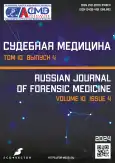The influence of individual characteristics of the research subject on the electrical conductivity parameters of cerebrospinal fluid
- Authors: Vavilov A.Y.1, Pozdeev A.R.1, Khalikov A.А.2, Bayandina S.M.1, Agzamov V.V.2, Pozdeyeva M.A.3
-
Affiliations:
- Izhevsk State Medical Academy
- Bashkir State Medical University
- Bauman Moscow State Technical University
- Issue: Vol 10, No 4 (2024)
- Pages: 462-473
- Section: Original study articles
- URL: https://journal-vniispk.ru/2411-8729/article/view/288316
- DOI: https://doi.org/10.17816/fm16178
- ID: 288316
Cite item
Abstract
Background: The analysis of cerebrospinal fluid has been repeatedly recognized in the scientific literature as a promising forensic tool for addressing critical questions related to fatal traumatic brain injuries, such as determining its age and assessing its severity. Conductometry has long been used in medicine as an objective method for studying biological samples. However, the influence of individual characteristics of the object on the conductometric properties of cerebrospinal fluid remains insufficiently studied.
Aim: To investigate the electrical conductivity properties of cerebrospinal fluid in deceased individuals who died from traumatic brain injuries, considering individual characteristics of autopsy material to substantiate the poteвntial of conductometric analysis as a research tool for determining the time of traumatic impact leading to injury formation.
Materials and methods: The experimental conductometric study was carried out on cerebrospinal fluid samples from 124 corps of persons aged 17 to 93 years who had died from traumatic brain injury and its consequences (with post-injury intervals ranging from 0 to 10 days). The electrical conductivity was measured using the AKIP RLC 6109 device, with an error of 0.1%, at frequencies of 0.1 kHz, 1 kHz, and 10 kHz. The study considered the subject’s sex, age, postmortem interval, presence of ethanol in the blood at the time of death, and the ethanol concentration.
Results: The subject’s sex was found to be a significant factor influencing the value of electrical conductivity of cerebrospinal fluid. In contrast, the deceased’s chronological age did not significantly affect the measured cerebrospinal fluid properties, nor did the postmortem interval within the first 24 hours. The absolute ethanol concentration (in ‰) had no substantial effect on cerebrospinal fluid conductivity. However, the mere presence of ethanol in the sample significantly altered its ability to conduct electrical current.
Conclusion: The influence of the above factors must be considered when developing a conductometric method for studying cerebrospinal fluid in those deceased from traumatic brain injury, as it can impact the assessment of injury severity and the age of injury.
Full Text
##article.viewOnOriginalSite##About the authors
Alexey Yu. Vavilov
Izhevsk State Medical Academy
Email: izhsudmed@hotmail.com
ORCID iD: 0000-0002-9472-7264
SPIN-code: 3275-3730
MD, Dr. Sci. (Medicine), Professor
Russian Federation, IzhevksAlexey R. Pozdeev
Izhevsk State Medical Academy
Email: apozdeev@bk.ru
ORCID iD: 0000-0002-6302-5219
SPIN-code: 2242-4828
MD, Dr. Sci. (Medicine), Assistant Professor
Russian Federation, IzhevksAirat А. Khalikov
Bashkir State Medical University
Email: airat.expert@mail.ru
ORCID iD: 0000-0003-1045-5677
SPIN-code: 1895-7300
MD, Dr. Sci. (Medicine), Professor
Russian Federation, UfaSophia M. Bayandina
Izhevsk State Medical Academy
Email: bay_sofia@mail.ru
ORCID iD: 0009-0005-9888-512X
SPIN-code: 8604-6691
Russian Federation, Izhevsk
Vadim V. Agzamov
Bashkir State Medical University
Author for correspondence.
Email: expert.sudmed@yandex.ru
ORCID iD: 0000-0001-9845-2280
SPIN-code: 2601-5485
Russian Federation, Ufa
Maria A. Pozdeyeva
Bauman Moscow State Technical University
Email: mashapozdeeva5@gmail.com
ORCID iD: 0009-0007-6403-9886
SPIN-code: 4731-6769
Russian Federation, Moscow
References
- Viter VI, Surkov YG, Pozdeev AR, et al. Assessment of craniocerebral trauma severity by specific electrical conductivity spectra of cerebrospinal fluid in the early postmortem period. Problemy ekspertizy v meditsine. 2004;4(3):12–14. EDN: OKGUTZ
- Gaivoronskaya VI. Crystallographic method of diagnostics of craniocerebral trauma and some pathological conditions in forensic medical practice [dissertation abstract]: 14.00.24. Place of protection: Russian Centre of Forensic Medical Examination. Moscow; 2001. 30 р. (In Russ.)
- Mainovskaya OA. Forensic medical assessment of craniocerebral trauma in living persons by crystallographic characteristics of cerebrospinal fluid [dissertation abstract]: 14.00.24. Moscow; 2001. 21 р. (In Russ.) EDN: ZLCDDF
- Chumutin AN. Study of liquor impedance for postmortem assessment of craniocerebral trauma. In: Young science — practical healthcare: Materials of the 92nd final scientific-practical conference of students, residents, postgraduates, young scientists (up to 35 years old) of E.A. Wagner Perm State Medical University, Perm, 15–16 April. Perm: Perm State Medical University named after Academician E.A. Wagner; 2019. Р. 43–44. (In Russ.) EDN: FQOJYH
- Zuev AL, Mishlanov VYu, Sudakov AI, Shakirov NV. Analysis of ionic, molecular and cellular mechanisms of electrical impedance formation in biological fluids and tissues. Perm scientific center journal. 2014;(2):69–78. EDN: SLQOVJ
- Pikalyuk VS, Bessalova EY, Tkach VV, et al. Liquor as humoral environment of the organism: Monograph. Simferopol: Arial; 2010. 192 р. (In Russ.) EDN: GWTTCQ
- Pozdeev AR. Forensic medical evaluation of treatment defects in the premortem period: Monograph. Nizhny Novgorod; 2004. 143 р. (In Russ.) EDN: QLKTZX
- Dobrovolsky GF. Topographic substantiation of the complex forensic-medical evaluation of the system of liquor circulation in traumatic brain injury [dissertation abstract]: 14.00.24. Place of defence: Moscow State Medical and Dental University named after A.I. Evdokimov. Moscow; 2003. 39 р. (In Russ.)
- Sarsenov TK. The forensic evaluation of traumatic brain injury. Nauka i Zdravookhranenie. 2013;(4):66–68. EDN: XIKOXL
- Glantz S. Medico-biological statistics. Transl. from English Yu.A. Danilov, ed. by N.E. Buzikashvili, D.V. Samoilov. Moscow: Praktika; 1999. 459 р. (In Russ.)
- Naumov ES. Expert system of diagnostics of acute poisoning (for the purposes of forensic medical practice) [dissertation abstract]: 14.00.24. Place of defence: Russian Centre of Forensic Medical Examination. Moscow; 2000. 24 р. (In Russ.)
- Korotun VN, Lesnikov VV, Viter VI. Changes in synthesised ethanol during storage of cadaver blood under room temperature conditions. Problemy ekspertizy v meditsine. 2013;13(1):9–12. EDN: QZRSCV
- Khalikov AA, Vavilov AYu. Diagnostics of the age of mechanical trauma in forensic medicine by biophysical methods: Monograph. Izhevsk; 2007. 159 р. (In Russ.) EDN: QLOUDP
- Permyakov AV, Viter VI. Pathomorphology and thanatogenesis of alcohol intoxication: Monograph. Izhevsk: Ekspertiza; 2002. 91 р. (In Russ.) EDN: XVIWWD
Supplementary files








